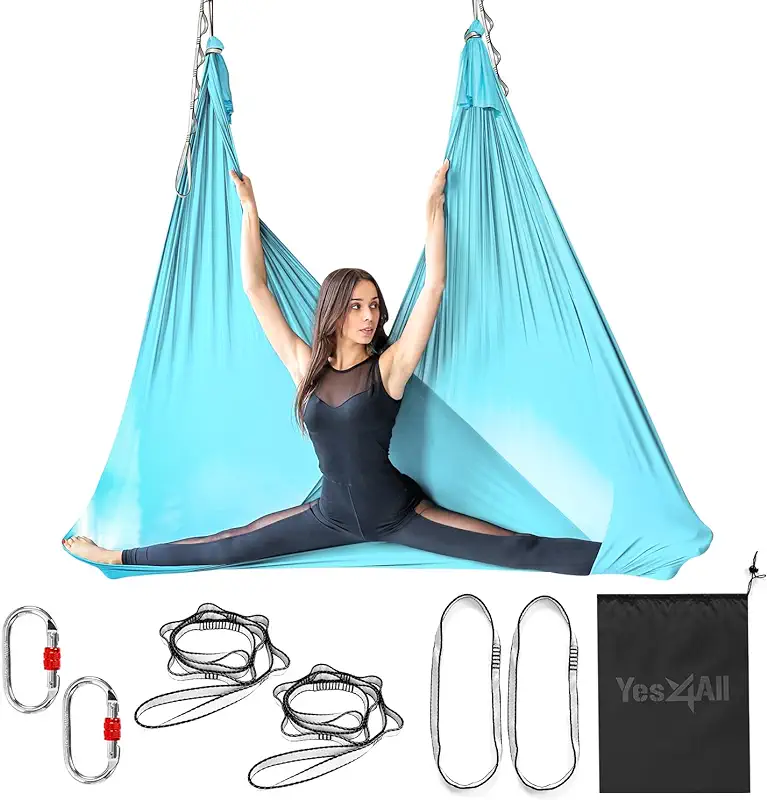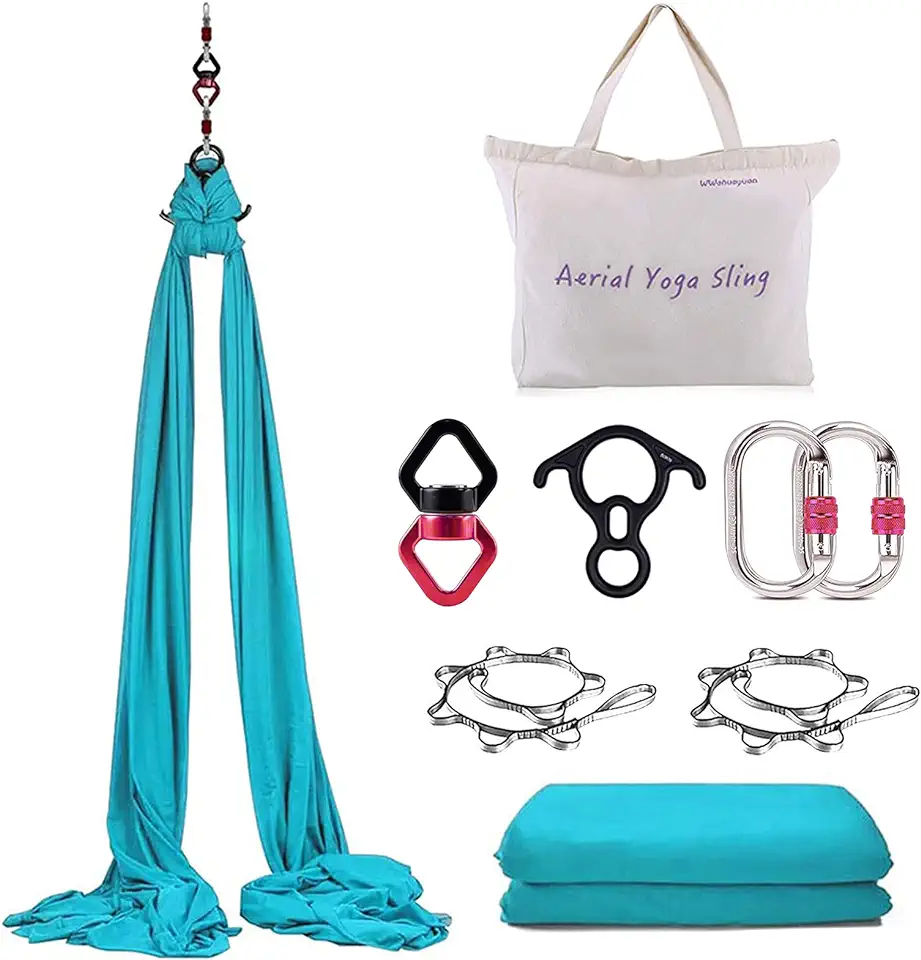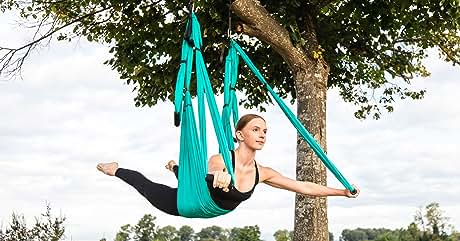Discover the benefits of sweatbands for your fitness routine. Enhance your performance and stay comfortable with these stylish and functional accessories.


A yoga swing is a versatile and innovative piece of equipment that can be used for various yoga poses, aerial exercises, and inversion therapy. It consists of a hammock-like fabric material that is suspended from the ceiling or a stand, allowing users to practice yoga poses and stretches in a suspended position. Yoga swings provide support, stability, and flexibility, making it easier for practitioners to perform advanced yoga poses and inversions.
Using a yoga swing allows you to stretch deeper and hold poses for longer periods of time, which can help improve flexibility and increase your range of motion. The fabric material provides support and stability, allowing you to safely push your body to new limits and explore different yoga poses.
Practicing yoga poses and exercises on a swing requires you to engage your core muscles and other muscle groups to maintain balance and stability. This can help strengthen your core, arms, legs, and back muscles, leading to improved overall strength and stability.
Inversion therapy, which involves hanging upside down or at an inverted angle, can help decompress the spine and relieve pressure on the discs and nerves. Using a yoga swing allows you to safely and comfortably practice inversion therapy, which can help alleviate back pain, improve posture, and increase blood flow to the brain.
Hanging in a yoga swing in a suspended position can help promote relaxation and relieve stress. The gentle swaying motion and the feeling of weightlessness can help calm the mind, reduce tension in the body, and promote a sense of relaxation and well-being.
Using a yoga swing requires you to be fully present in the moment and pay close attention to your body and breath. This can help increase body awareness and mindfulness, allowing you to deepen your yoga practice and cultivate a greater sense of self-awareness.

Start by finding a suitable location to hang your yoga swing. This could be a sturdy ceiling beam, a tree branch, or a specially designed stand. Make sure the area is clear of any obstacles and provides enough space for you to move freely.
Next, attach the yoga swing to the chosen anchor point using the included straps or carabiners. Make sure the swing is securely attached and can support your body weight.
Before using the yoga swing, it’s important to warm up your body and stretch your muscles. This will help prevent injuries and prepare your body for the upcoming exercises and poses.
Perform a series of dynamic stretches, such as arm circles, leg swings, and spinal twists, to warm up your muscles and increase blood flow to the joints.
If you’re new to using a yoga swing, it’s best to start with basic poses and exercises to familiarize yourself with the equipment and build strength and stability.
Some basic poses you can try on the yoga swing include the supported plank, the supported downward dog, and the supported backbend. These poses will help you get used to the feeling of being suspended and build confidence in using the yoga swing.
Once you feel comfortable and confident using the yoga swing, you can progress to more advanced poses and exercises. These may include inversions, aerial yoga poses, and challenging strength-building exercises.
Always listen to your body and only go as far as feels comfortable for you. It’s important to practice proper form and alignment to prevent injuries and get the most out of your yoga swing practice.
After your yoga swing practice, take some time to cool down and relax. Perform gentle stretches and deep breathing exercises to release any tension in your muscles and promote relaxation.
You can also use the yoga swing to gently swing back and forth, allowing your body to relax and decompress further.
When using a yoga swing for the first time, start with basic poses and exercises and gradually progress to more advanced ones. Listen to your body and only go as far as feels comfortable for you. If something doesn’t feel right or causes pain, stop and adjust your position.
Make sure the yoga swing is securely anchored to a stable and sturdy point. If using a stand, ensure it is properly assembled and can support your body weight. Avoid using the swing on weak or unstable surfaces.
Pay attention to your form and alignment when using the yoga swing. This will help prevent injuries and ensure you get the most out of your practice. If you’re unsure about proper form, consider taking a class or working with a qualified instructor.
As you become more comfortable and confident using the yoga swing, you can gradually increase the intensity and duration of your practice. Challenge yourself with more advanced poses and exercises, but always within your comfort zone.
Stay hydrated during your yoga swing practice by drinking watehttps://infocedia.com/owala-water-bottles-stay-hydrated-stylish/r before, during, and after your session. Take regular breaks to rest and allow your body to recover. Listen to your body’s signals and take breaks whenever needed.
If you have any pre-existing medical conditions or injuries, it’s important to consult with a healthcare professional before using a yoga swing. They can provide guidance and recommendations based on your individual needs and help ensure your safety during your practice.

When choosing a yoga swing, there are several factors to consider to ensure you find the right one for your needs:
Yoga swings are typically made from a durable and supportive fabric material, such as parachute nylon or silk. Consider the material’s strength, durability, and comfort when choosing a yoga swing. Look for a swing that can support your body weight and is comfortable to use for extended periods of time.
Check the weight capacity of the yoga swing to ensure it can safely support your body weight. Most yoga swings have a weight capacity of around 300-400 pounds, but it’s important to confirm this before making a purchase.
Look for a yoga swing that comes with adjustable straps or ropes. This will allow you to easily adjust the height of the swing to accommodate your height and the specific poses or exercises you want to do.
Ensure the yoga swing has safety features, such as reinforced stitching, sturdy carabiners, and secure straps. These features will help ensure the swing is safe and reliable to use.
If you plan to travel with your yoga swing or use it in different locations, consider the portability of the swing. Look for a lightweight and compact swing that is easy to pack and transport.
Check how easy it is to install and set up the yoga swing. Look for a swing that comes with clear instructions and all the necessary hardware for installation. Consider whether you will need additional equipment, such as ceiling hooks or a stand, and factor in the cost and ease of installation.
Research the brand reputation and read customer reviews before purchasing a yoga swing. This will give you an idea of the quality, durability, and performance of the swing. Look for a reputable brand with positive reviews and testimonials.
To perform a supported plank on a yoga swing, start by sitting on the swing and placing your feet on the ground. Lean back and extend your legs out in front of you, lifting your hips off the ground. Place your hands on the swing handles, keeping your arms straight and shoulders stacked over your wrists. Engage your core and hold the pose for 30 seconds to 1 minute.
To perform a supported downward dog on a yoga swing, start by standing facing the swing and placing your hands on the swing handles. Walk your feet back, keeping your legs straight and your hips lifted. Allow your head and neck to relax between your arms. Hold the pose for 30 seconds to 1 minute, focusing on lengthening your spine and stretching your hamstrings and calves.
To perform a supported backbend on a yoga swing, start by sitting on the swing and placing your feet on the ground. Lean back and extend your legs out in front of you, lifting your hips off the ground. Reach your arms overhead and hold onto the swing handles. Allow your head and neck to relax, arching your back and opening your chest. Hold the pose for 30 seconds to 1 minute, focusing on deepening the stretch in your back and shoulders.
To perform an inverted pike on a yoga swing, start by sitting on the swing and placing your feet on the ground. Lean back and extend your legs out in front of you, lifting your hips off the ground. Reach your arms overhead and hold onto the swing handles. Engage your core and lift your legs up, bringing your body into an inverted V shape. Hold the pose for 30 seconds to 1 minute, focusing on engaging your core and stretching your hamstrings.
Once you feel comfortable using a yoga swing, you can explore various aerial yoga poses. These may include the flying pigeon, the flying lizard, and the flying splits. Always practice these poses under the guidance of a qualified instructor to ensure proper form and alignment.
In addition to yoga poses, you can use the yoga swing to perform strength-building exercises. These may include hanging leg raises, pull-ups, and tricep dips. Gradually increase the intensity and difficulty of these exercises as you build strength and stability.

While using a yoga swing can offer numerous benefits, it’s important to take certain precautions and consider your individual needs and limitations:
If you have any pre-existing medical conditions, such as high blood pressure, glaucoma, or herniated discs, or if you’re pregnant, it’s important to consult with a healthcare professional before using a swing. They can provide guidance and recommendations based on your individual needs and help ensure your safety during your practice.
When using a yoga swing for the first time or trying new poses, start slowly and listen to your body. Only go as far as feels comfortable for you and avoid forcing yourself into positions that cause pain or discomfort.
While using a swing can be challenging and invigorating, it’s important to avoid overexertion. Take breaks when needed, stay hydrated, and pay attention to your body’s signals. Push yourself within your comfort zone, but avoid pushing beyond your limits.
Pay attention to your form and alignment when using the swing. This will help prevent injuries and ensure you get the most out of your practice. If you’re unsure about proper form, consider taking a class or working with a qualified instructor.
Inversions, such as hanging upside down or at an inverted angle, can provide numerous benefits, but they can also put strain on the neck and shoulders if not done properly. If you’re new to inversions or have any neck or shoulder issues, start with gentle inversions and gradually build up to more advanced poses. Always practice inversions under the guidance of a qualified instructor.
Before using a yoga swing, check the area for any safety hazards, such as sharp objects or low ceilings. Ensure the swing is properly anchored and can support your body weight. Regularly inspect the swing for any signs of wear and tear, such as frayed fabric or loose stitching, and replace it if necessary.
When using a yoga swing, practice mindfully and stay present in the moment. Pay attention to your body, breath, and sensations. If your mind starts to wander or you become distracted, gently bring your attention back to your practice.
– Increased flexibility and range of motion.
– Improved strength and core stability.
– Decompression of the spine during inversion therapy.
– Relaxation and stress relief.
– Increased body awareness and mindfulness.
– Requires a suitable location and secure anchoring.
– May not be suitable for individuals with certain medical conditions or injuries.
– Initial learning curve for beginners.
– Requires proper form and alignment to prevent injuries.
– Can be costly to purchase.
– “I love using my swing for aerial yoga! It adds a whole new dimension to my practice and helps me deepen my stretches.” – Sarah M.
– “Using a yoga swing has been a game changer for my back pain. The inversion therapy really helps relieve the pressure on my spine.” – John D.
– “I was hesitant to try a yoga swing at first, but after a few sessions, I’m hooked. It’s so much fun and makes me feel weightless!” – Emily T.

Yes, anyone can use a swing, but it’s important to consult with a healthcare professional if you have any pre-existing medical conditions or injuries.
Most yoga swings can be cleaned by wiping them down with a damp cloth or using a mild detergent. Be sure to follow the manufacturer’s instructions for cleaning.
Yes, some yoga swings are designed for outdoor use. However, be mindful of the weather conditions and ensure the swing is securely anchored to a stable structure.
Yes, a yoga swing can be used for aerial yoga. It provides support and stability for performing aerial poses and allows for greater flexibility and range of motion.
It’s best to consult with a healthcare professional before using a swing during pregnancy. They can provide guidance based on your individual circumstances.

A yoga swing is a versatile and innovative tool for enhancing your yoga practice and experiencing the benefits of inversion therapy. It offers increased flexibility, improved strength and stability, spinal decompression, relaxation, and mindfulness. While there may be a learning curve for beginners and the need for proper safety precautions, the overall benefits make a swing a worthy investment for those looking to expand their yoga practice and improve their overall well-being.
A yoga swing is a versatile and effective tool for enhancing your yoga practice, improving flexibility, strength, and stability, and promoting relaxation and stress relief. By choosing the right swing, practicing proper form and alignment, and listening to your body, you can safely and confidently enjoy the numerous benefits of using a yoga swing for years to come.